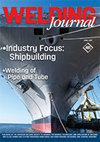The Effect of a Hollow Fixture on Energy Dissipation of Ultrasonic Welded Carbon Fiber/Polyamide 66 Composite
IF 1.4
3区 材料科学
Q2 METALLURGY & METALLURGICAL ENGINEERING
引用次数: 4
Abstract
In this study, the effect of the fixture configuration on ultrasonic welding of 4-mm-thick carbon-fiber-reinforced polyamide 66 (CF/PA66) composite with 30% mass fiber was evaluated. An analytical model to estimate the energy dissipation in the welding zone of lapped CF/PA66 samples was derived. Calculation analyses showed the energy dissipation at the faying interface of joints made from hollow-fixture ultrasonic welding (HFUSW) was about 25% higher than those made from conventional ultrasonic welding (CUSW) under the given process variables. This was primarily attributed to the almost total reflection at the workpiece-to-fixture interface in HFUSW. Experimental results indicated that the HFUSW joints exhibited a greater peak load and weld area than CUSW joints when the weld time was less than 2.1 s. The optimal weld time for CUSW and HFUSW processes were 2.1 and 1.7 s. When the weld time exceeded the optimal time, the joints occurred with a porous region, which was caused by thermal decomposition of the material, resulting in the decrease in peak load. Experimental and simulation results demonstrated the HFUSW process changed the propagation behavior of the ultrasonic wave and enhanced the energy dissipation at the faying interface. This study enriched the understanding of energy dissipation during ultrasonic welding of polymers.中空夹具对超声焊接碳纤维/聚酰胺66复合材料能量耗散的影响
在本研究中,评估了夹具配置对含30%质量纤维的4mm厚碳纤维增强聚酰胺66 (CF/PA66)复合材料超声焊接的影响。建立了CF/PA66搭接试样焊接区能量耗散的解析模型。计算分析表明,在一定的工艺变量下,空心夹具超声焊接接头接合界面处的能量耗散比常规超声焊接接头高25%左右。这主要归因于HFUSW中工件与夹具界面的几乎全反射。实验结果表明,当焊接时间小于2.1 s时,HFUSW接头的峰值载荷和焊缝面积均大于CUSW接头。CUSW和HFUSW工艺的最佳焊接时间分别为2.1 s和1.7 s。当焊接时间超过最佳时间时,接头出现多孔区域,这是由于材料的热分解造成的,导致峰值载荷降低。实验和仿真结果表明,HFUSW工艺改变了超声波的传播特性,增强了接触面处的能量耗散。该研究丰富了对聚合物超声焊接过程能量耗散的认识。
本文章由计算机程序翻译,如有差异,请以英文原文为准。
求助全文
约1分钟内获得全文
求助全文
来源期刊

Welding Journal
工程技术-冶金工程
CiteScore
3.00
自引率
0.00%
发文量
23
审稿时长
3 months
期刊介绍:
The Welding Journal has been published continually since 1922 — an unmatched link to all issues and advancements concerning metal fabrication and construction.
Each month the Welding Journal delivers news of the welding and metal fabricating industry. Stay informed on the latest products, trends, technology and events via in-depth articles, full-color photos and illustrations, and timely, cost-saving advice. Also featured are articles and supplements on related activities, such as testing and inspection, maintenance and repair, design, training, personal safety, and brazing and soldering.
 求助内容:
求助内容: 应助结果提醒方式:
应助结果提醒方式:


